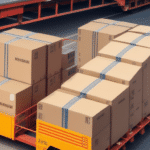Strengthening Supply Chain Resilience for a More Secure Future
As globalization continues to shape the business landscape, supply chain resilience has become increasingly important. A resilient supply chain helps companies manage risks, enhance their agility and responsiveness, and achieve long-term success in an unpredictable and volatile market.
The Importance of a Resilient Supply Chain in Today's Global Economy
A resilient supply chain is critical for companies operating in today's global economy, where supply chains have become increasingly complex and interconnected. In a world where disruptions are becoming more frequent and severe, companies need to be prepared for unexpected events such as natural disasters, political instability, trade disputes, and cyber-attacks. Failure to do so can result in severe consequences, including supply chain disruptions, stockouts, lost revenue, reputational damage, and even business failure.
To build a resilient supply chain, consider the following strategies:
- Diversify Suppliers and Manufacturing Locations: Mitigate the impact of disruptions in one region or with one supplier by spreading risks across multiple sources.
- Invest in Technology and Data Analytics: Utilize advanced tools to better predict and respond to potential disruptions.
- Collaborate with Suppliers and Stakeholders: Enhance communication and coordination to build a more resilient supply chain.
Understanding the Risks and Vulnerabilities in Your Supply Chain
The first step in building resilience is to identify the risks and vulnerabilities in your supply chain. This involves:
- Analyzing Your Supply Chain Network: Map out your entire supply chain to understand its complexity and interconnections.
- Mapping Critical Suppliers: Assess the capacity, lead times, and quality standards of your key suppliers.
- Evaluating Transportation and Inventory Risks: Consider risks associated with transportation, inventory management, demand variability, and supplier performance.
Additionally, the geopolitical climate plays a significant role. Political instability, trade wars, and natural disasters can all impact your supply chain. Staying informed about global events allows you to develop contingency plans and minimize their effects on your business.
Best Practices and Strategies to Build a Resilient Supply Chain
Demand Planning and Inventory Management
Implement accurate forecasting to anticipate demand changes. Reduce lead times and maintain safety stocks to cushion against supply fluctuations.
Supplier Collaboration
Establish strong relationships with suppliers through regular communication and information sharing. Collaborate on problem-solving to anticipate and mitigate potential disruptions.
Technology Adoption
Leverage technology to improve supply chain visibility and transparency. Utilize tools for tracking inventory levels, monitoring supplier performance, and analyzing data to identify trends and patterns.
Risk Management
Develop comprehensive risk management plans that include diversification of suppliers, contingency sourcing strategies, and continuous monitoring of potential threats.
The Role of Technology in Strengthening Supply Chain Resilience
Technology plays a pivotal role in enhancing supply chain resilience. Key technological advancements include:
- Big Data Analytics: Analyze vast amounts of data to predict disruptions and optimize supply chain operations.
- Artificial Intelligence (AI): Automate decision-making processes and improve demand forecasting accuracy.
- Blockchain: Ensure transparency and traceability across the supply chain, enhancing trust and accountability.
- Internet of Things (IoT): Monitor real-time data from various points in the supply chain to detect and respond to issues promptly.
By embracing these technologies, companies can improve communication and collaboration with suppliers, partners, and customers, resulting in a more responsive and agile supply chain.
Collaboration with Suppliers, Partners, and Customers to Enhance Resilience
Collaboration is essential for building a resilient supply chain. Benefits include:
- Information Sharing: Gain insights into potential risks and vulnerabilities by sharing data with supply chain partners.
- Joint Risk Mitigation: Develop and implement strategies together to address shared risks.
- Sustainability Practices: Work with partners to implement sustainable practices, enhancing reputation and meeting consumer demands for social responsibility.
Effective collaboration fosters trust and long-term relationships, creating new opportunities for growth and innovation.
Case Studies: Real-World Examples of Strengthened Supply Chains
Walmart
Walmart developed a supplier sustainability index to evaluate its suppliers based on their environmental and social performance. This initiative helped Walmart manage risks related to compliance and improve supply chain transparency.
Apple
Apple implemented a risk mapping tool to assess risks associated with its suppliers' operations. This tool enables Apple to develop contingency plans and ensure continuity in its supply chain.
Nike
Nike adopted a lean manufacturing strategy to reduce waste and improve production efficiency. This approach allowed Nike to respond swiftly to demand changes and reduce lead times, enhancing customer satisfaction.
Toyota
Toyota utilized a just-in-time (JIT) inventory management system to minimize inventory costs and streamline production processes. This system enabled Toyota to adapt quickly to demand fluctuations and maintain high levels of customer service.
Measuring Supply Chain Resilience: Key Metrics and Performance Indicators
Measuring supply chain resilience is crucial for tracking progress and identifying improvement areas. Key metrics include:
- Lead Times: Monitor the time taken from order placement to delivery.
- Inventory Levels: Assess stock levels to balance demand fulfillment and cost efficiency.
- On-Time Delivery: Track the percentage of orders delivered on schedule.
- Supplier Performance: Evaluate suppliers based on reliability, quality, and responsiveness.
- Risk Exposure: Measure the extent of potential risks within the supply chain.
Additionally, the speed of adapting to disruptions and the level of collaboration among supply chain partners are critical indicators of resilience. Regularly tracking these metrics allows companies to proactively address potential disruptions and enhance overall supply chain performance.
Overcoming Challenges to Building a Resilient Supply Chain
Building a resilient supply chain involves overcoming several challenges:
- Lack of Visibility and Transparency: Invest in technologies like blockchain and IoT to gain real-time insights into the supply chain.
- Complex Global Trade Regulations: Implement compliance management systems and collaborate closely with suppliers and logistics partners to navigate regulatory requirements.
- Resource and Budget Constraints: Prioritize investments in critical areas that offer the highest return in terms of resilience.
- Cultural Barriers and Resistance to Change: Foster a culture that embraces change and continuous improvement through leadership and training.
The Future of Supply Chain Resilience: Trends and Predictions
The future of supply chain resilience will be influenced by several key trends:
- Sustainability and Circular Economy: Increasing focus on environmentally friendly practices and reducing waste.
- Advanced Data Analytics and AI: Enhanced predictive capabilities and automation in supply chain management.
- Emerging Technologies: Wider adoption of blockchain and IoT for improved transparency and efficiency.
- Increased Collaboration: Strengthened partnerships and alliances across the supply chain to share risks and resources.
Climate-related events and natural disasters will continue to pose significant challenges, necessitating investment in sustainable and adaptable supply chain practices. Emphasizing local sourcing, supplier diversification, and renewable energy adoption will be critical for future resilience.
Conclusion: The Essential Investment in Supply Chain Resilience for Long-Term Success
Investing in supply chain resilience is vital for long-term success in an unpredictable and volatile market. A resilient supply chain enhances agility, responsiveness, and risk management capabilities, while also improving reputation, customer relationships, and profitability.
Key benefits of investing in resilience include:
- Enhanced Disruption Management: Quickly adapt to unexpected events, minimizing operational impact and maintaining customer satisfaction.
- Proactive Risk Mitigation: Identify and address risks before they materialize, preventing costly downtime and ensuring supply chain transparency.
- Improved Compliance and Transparency: Meet regulatory requirements and consumer expectations for ethical and sustainable practices.
By prioritizing supply chain resilience, companies can secure a competitive advantage and ensure sustained growth and stability in the face of future challenges.






















